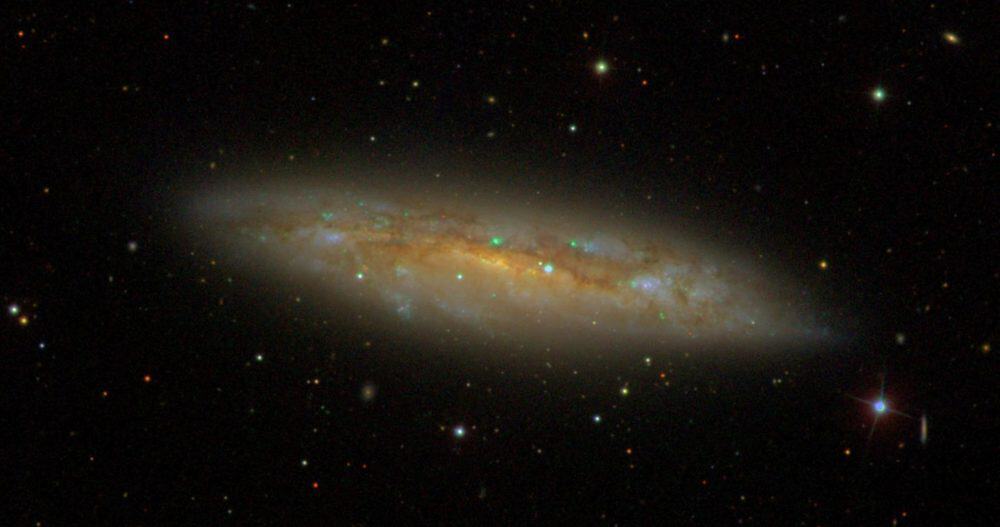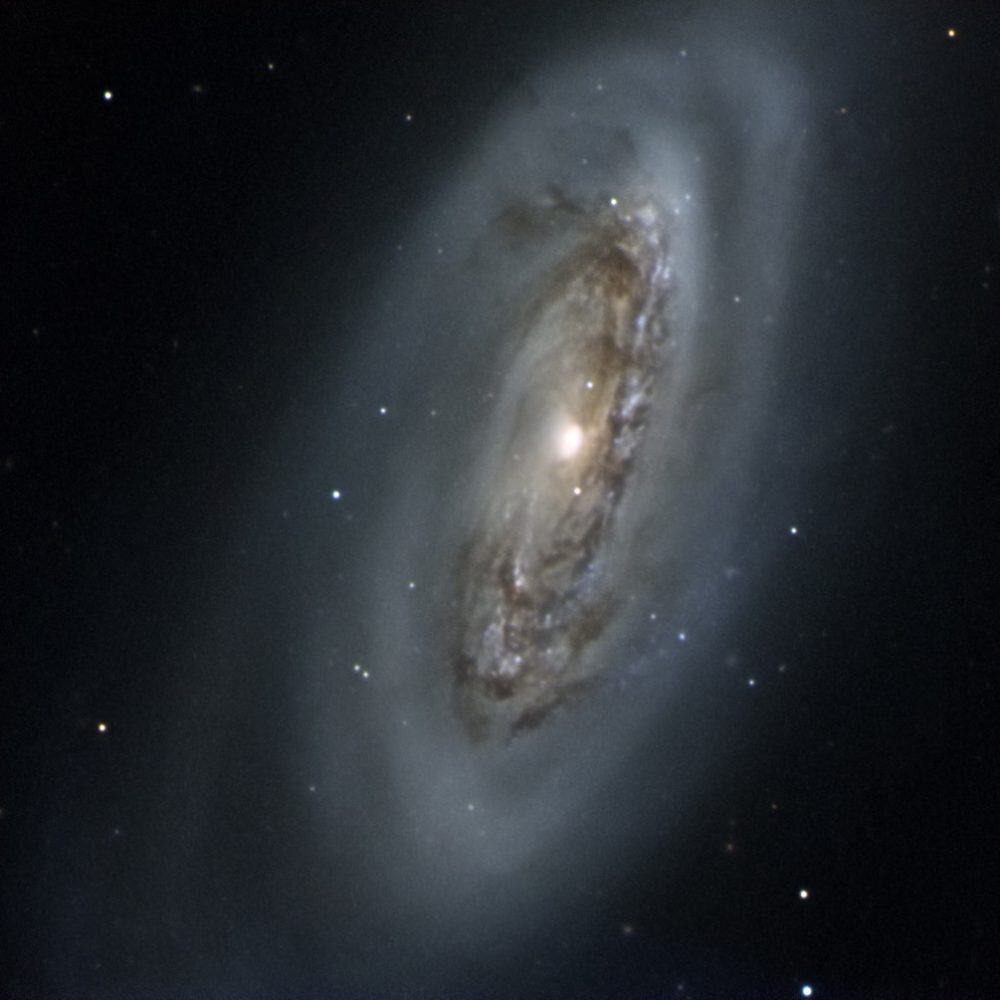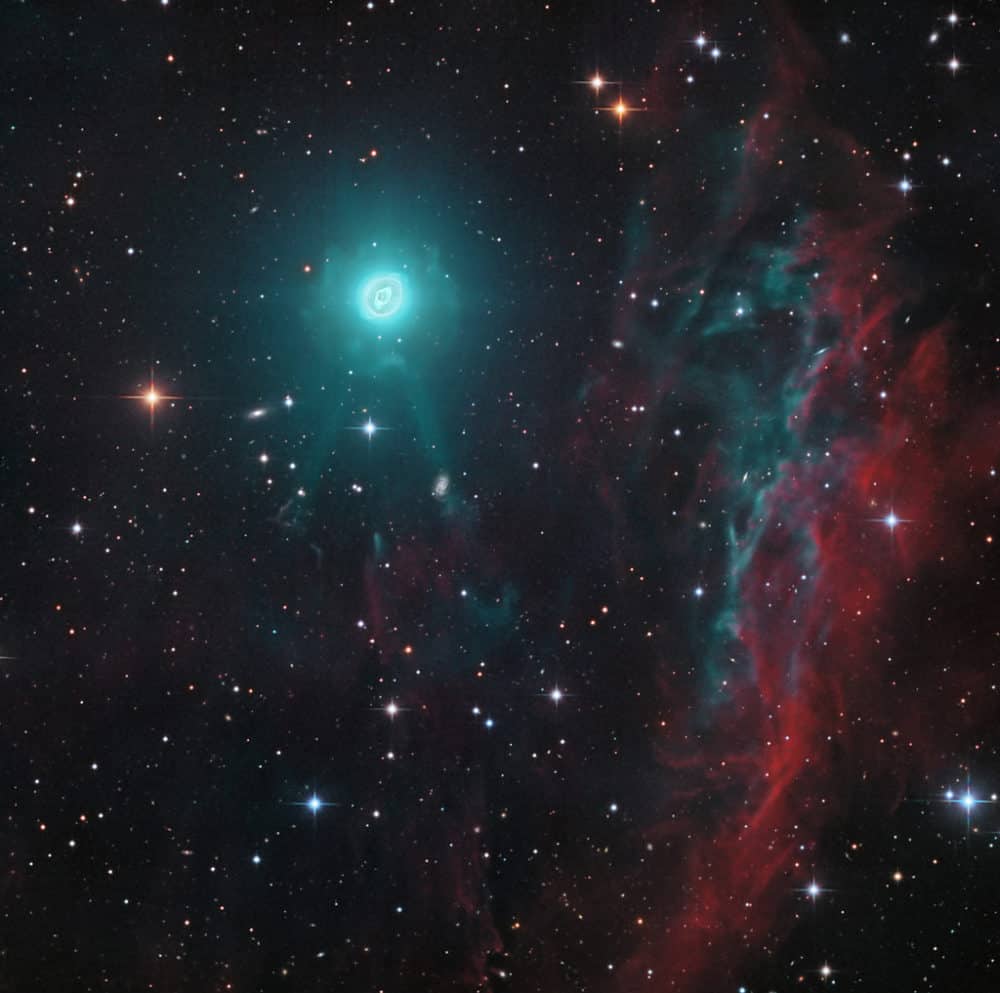Blog
NGC 3147 is a spiral galaxy located in the constellation Draco. It is located at a distance of circa 130 million light years from Earth, which, given its apparent dimensions, means that NGC 3147 is about 140,000 light years across. It was discovered by William Herschel οn April 3, 1785. It is a Type II Seyfert galaxy.
Hubble Uncovers Black Hole Disk that Shouldn’t Exist
As if black holes weren’t mysterious enough, astronomers using NASA’s Hubble Space Telescope have found an unexpected thin disk of material furiously whirling around a supermassive black hole at the heart of the magnificent spiral galaxy NGC 3147, located 130 million light-years away.
The conundrum is that the disk shouldn’t be there, based on current astronomical theories. However, the unexpected presence of a disk so close to a black hole offers a unique opportunity to test Albert Einstein’s theories of relativity. General relativity describes gravity as the curvature of space and special relativity describes the relationship between time and space.
https://www.nasa.gov/feature/goddard/2019/hubble-uncovers-black-hole-that-shouldnt-exist

The shape and structure of this Spiral galaxy are plainly visible thanks to this perspective. Galaxy NGC 3147 galaxy is relatively close by, at a distance of roughly 130 million light-years, and can be found in the constellation of Draco (The Dragon).
more...
Angélique Kpasseloko Hinto Hounsinou Kandjo Manta Zogbin Kidjo, known as Angélique Kidjo (born July 14, 1960), is a Beninese–American singer-songwriter, actress, and activist who is noted for her diverse musical influences and creative music videos. Time magazine has called her “Africa’s premier diva”. The BBC has included Kidjo in its list of the African continent’s 50 most iconic figures.The Guardian has listed her as one of its Top 100 Most Inspiring Women in the World and Kidjo is the first woman to be listed among “The 40 Most Powerful Celebrities in Africa” by Forbes magazine. The Daily Telegraph in London described her as “The undisputed queen of African music” during the 2012 Olympic Games River of Music Festival. In March 2013, National Public Radio (NPR) in America, called her “Africa’s greatest living diva”. Kidjo is listed among the “2014 Most Influential Africans” by New African magazine and Jeune Afrique. Forbes Afrique put Kidjo on the cover of their “100 most influential women” issue in 2015. On June 6, 2013, Kidjo was elected vice-president of the Confédération Internationale des Sociétés d´Auteurs et Compositeurs (CISAC). She now resides in New York City, where she is an occasional contributor to The New York Times. Kidjo has received Honorary Doctorates from Yale University, Berklee College of Music and Middlebury College. She is the 2018 Harvard UniversityJazz Master In Residence.
Her musical influences include the Afropop, Caribbean zouk, Congolese rumba, jazz, gospel, and Latin styles; as well as her childhood idols Bella Bellow, James Brown, Nina Simone, Aretha Franklin, Jimi Hendrix, Miriam Makeba and Carlos Santana. She has recorded George Gershwin’s “Summertime“, Ravel’s Boléro, Jimi Hendrix’s “Voodoo Child” and the Rolling Stones‘ “Gimme Shelter“, and has collaborated with Dave Matthews and the Dave Matthews Band, Kelly Price, Alicia Keys, Branford Marsalis, Ziggy Marley, Philip Glass, Peter Gabriel, Bono, Carlos Santana, John Legend, Herbie Hancock, Josh Groban, Dr John, the Kronos Quartet and Cassandra Wilson. Kidjo’s hit songs include “Agolo”, “We We”, “Adouma”, “Wombo Lombo”, “Afirika”, “Batonga“, and her version of “Malaika“. Her album Logozo is ranked number 37 in the Greatest Dance Albums of All Time list compiled by Vice magazine’s Thump website.
Kidjo is fluent in five languages: Fon, French, Yorùbá, Gen (Mina), and English. She sings in all of them, and she also has her own personal language, which includes words that serve as song titles such as “Batonga”. “Malaika” is a song sung in the Swahili language. Kidjo often uses Benin’s traditional Zilin vocal technique and vocalese.
Kidjo is the recipient of the 2015 Crystal Award given by the World Economic Forum of Davos in Switzerland and has received the Ambassador Of Conscience Award from Amnesty International in 2016 She also is included in the exhibits at the National Museum of African American History that opened on Sept. 24, 2016 on the National Mall.
more...Kenneth “Kenny” Napper (born July 14, 1933 in London) is an English jazz double-bassist.
Napper started out on piano as a child and picked up bass as a student at Guildhall School of Music. He entered the British military in the early 1950s, playing with Mary Lou Williams in 1953 during a leave period. After ending his term of duty, he played with Jack Parnell, Malcolm Mitchell, Vic Ash, and Cab Calloway. He was the house bassist at Ronnie Scott’s Jazz Club for several years and played with many British and American jazz musicians in the late 1950s and early 1960s, including Alan Clare, Ronnie Scott, Stan Tracey, Tubby Hayes, Tony Kinsey, Tony Crombie, Jimmy Deuchar, John Dankworth, Pat Smythe, Phil Seamen, Zoot Sims, Carmen McRae, and Paul Gonsalves. Later in the 1960s he worked with Ted Heath, Tony Coe, John Picard, and Barney Kessel, as well as with Gonsalves, Tracey, and Dankworth. In 1970 he played with Stephane Grappelli and moved to Germany, playing with Kurt Edelhagen from 1970 to 1972. While in Germany he focused more on composition and arrangement; later in the decade he moved to the Netherlands, where he arranged for radio ensembles.
more...Alan Dawson (July 14, 1929 – February 23, 1996) was a respected jazz drummer and widely influential percussion teacher based in Boston.
Dawson is best remembered as an early teacher of Tony Williams, and Sawyer Brown drummer, Joseph Smyth. Other former students include: Terri Lyne Carrington, Julian Vaughn, Vinnie Colaiuta, Steve Smith, Kenwood Dennard, Gerry Hemingway, Jeff Sipe, Billy Kilson, and many others. He began teaching at Berklee College of Music in 1957. Dawson suffered a ruptured disc in 1975 which led to him halting his touring schedule, to leave Berklee and limit his teaching to his home in Lexington, Massachusetts.
His teaching style emphasized the music as a whole rather than concentrate on percussion alone. He stressed the importance of learning the melody and structure of the tune to better fulfill the role of accompaniment. For this purpose, he had students play over standards while also singing the melody out loud. He constantly strived for balance between musical ideas and strict technique. He was big on rudiments and wrote extensive exercises intended to be practiced with brushes. He believed using brushes with his “Rudimental Ritual” would reduce stick rebound allowing the sense of “picking up” the sticks. While teaching, Alan also maintained a prolific performing and recording career.
https://www.youtube.com/watch?v=jm_qWpvjvm4
more...Messier 108 (also known as NGC 3556) is a barred spiral galaxy in the constellation Ursa Major. It was discovered by Pierre Méchain in 1781 or 1782. From the perspective of the Earth, this galaxy is seen almost edge-on.
This galaxy is an isolated member of the Ursa Major Cluster of galaxies in the Virgo supercluster. It has a morphological classification of type SBbc in the de Vaucouleurs system, which means it is a barred spiral galaxy with somewhat loosely wound arms. The maximum angular size of the galaxy in the optical band is 11′.1 × 4′.6, and it is inclined 75° to the line of sight.
This galaxy has an estimated mass of 125 billion times the mass of the Sun and includes about 290 ± 80 globular clusters. Examination of the distribution of neutral hydrogen in this galaxy shows shells of expanding gas extending for several kiloparsecs, known as H1 supershells. These may be driven by bursts of star formation activity, resulting in supernovae explosions. Alternatively they may result from an infall of gas from outside the galaxy or by radio jets.
Observations with the Chandra X-ray Observatory have identified 83 X-ray sources, including a source located at the nucleus. The brightest of these sources may be an intermediate-mass black hole that is accreting matter. The galaxy is also emitting a diffuse soft X-ray radiation within 10 kpc of the optical galaxy. The spectrum of the X-ray source at the core is consistent with an active galactic nucleus, but an examination with the Spitzer Space Telescope shows no indication of activity. The supermassive black hole at the core has an estimated mass equal to 24 million times the mass of the Sun.
more...Albert Ayler (/ˈaɪlər/; July 13, 1936 – November 25, 1970) was an American avant-garde jazz saxophonist, singer and composer. After early experience playing R&B and bebop, Ayler began recording music during the free jazz era of the 1960s. However, some critics argue that while Ayler’s style is undeniably original and unorthodox, it does not adhere to the generally accepted critical understanding of free jazz. In fact, Ayler’s style is difficult to categorize in any way, and it evoked incredibly strong and disparate reactions from critics and fans alike. His innovations have inspired subsequent jazz musicians.
His trio and quartet records of 1964, such as Spiritual Unity and The Hilversum Session, show him advancing the improvisational notions of John Coltrane and Ornette Coleman into abstract realms where whole timbre, and not just mainly harmony with melody, is the music’s backbone. His ecstatic music of 1965 and 1966, such as “Spirits Rejoice” and “Truth Is Marching In”, has been compared by critics to the sound of a brass band, and involved simple, march-like themes which alternated with wild group improvisations and were regarded as retrieving jazz’s pre-Louis Armstrongroots. Born in Cleveland, Ohio, Ayler was first taught alto saxophone by his father Edward, who was a semiprofessional saxophonist and violinist. Edward and Albert played alto saxophone duets in church and often listened to jazz records together, including swing era jazz and then-new bop albums.Ayler’s upbringing in the church had a great impact on his life and music, and much of his music can be understood as an attempt to express his spirituality, including the aptly titled Spiritual Unity, and his album of spirituals, Goin’ Home, which features “meandering” solos that are meant to be treated as meditations on sacred texts, and at some points as “speaking in tongues” with his saxophone.
Peter Michael Escovedo (born July 13, 1935 in Pittsburg, California) is a Mexican-American percussionist.
With his two brothers, Pete formed Escovedo Bros Latin Jazz Sextet, before Carlos Santana hired Pete and Coke Escovedo for his group. He led the 14–24 piece Latin big band Azteca.
He is the father of musicians Sheila Escovedo (Sheila E.), Peter Michael Escovedo, and Juan Escovedo; and dancer, manager and promoter Zina Escovedo. His brothers are fellow recording artists Alejandro Escovedo, Coke Escovedo, Javier Escovedo (The Zeros), Bobby Escovedo, and Mario Escovedo (The Dragons). He is the biological grandfather of Nicole Richie, daughter of son Peter Michael Escovedo.
Escovedo participated in the San Francisco music scene for several decades. In 2002, he appeared on the “By the Hand of the Father” episode of the PBS series Austin City Limits.
more...
Leroy Vinnegar (July 13, 1928 – August 3, 1999) was an American jazz bassist. Born in Indianapolis, the self-taught Vinnegar established his reputation in Los Angeles during the 1950s and 1960s. His trademark was the rhythmic “walking” bass line, a steady series of ascending or descending notes, and it brought him the nickname “The Walker”. Besides his jazz work, he also appeared on a number of soundtracks and pop albums, notably Van Morrison‘s 1972 album, Saint Dominic’s Preview. He recorded extensively as both a leader and sideman. He came to public attention in the 1950s as a result of recording with Lee Konitz, André Previn, Stan Getz, Shorty Rogers, Chet Baker, Shelly Manne, Joe Castro and Serge Chaloff.
He played bass on Previn and Manne’s My Fair Lady album, one of the most successful jazz records ever produced. He also performed on another of jazz’s biggest hit albums, Eddie Harris and Les McCann‘s Swiss Movement, released in 1969. Vinnegar also performed at the famous Lighthouse in Hermosa Beach, California, and Diggers in East Los Angeles in the late 1950s with drummer/pianist Don Joham along with other musicians. He moved to Portland, Oregon in 1986. In 1995, the Oregon State Legislature honored him by proclaiming May 1 Leroy Vinnegar Day.
Vinnegar died of a heart attack, at the age of 71, on August 3, 1999, in a hospital in Portland.
more...Messier 90 (also known as M90 and NGC 4569) is an intermediate spiral galaxy exhibiting a weak inner ring structure about 60 million light-yearsaway in the constellation Virgo. It was discovered by Charles Messier in 1781.
Messier 90 is a member of the Virgo Cluster, being one of its largest and brightest spiral galaxies, with an absolute magnitude of around -22 (brighter than the Andromeda Galaxy). The galaxy is located approximately 1°.5 away from the subgroup centered on Messier 87. As a consequence of the galaxy’s interaction with the intracluster medium in the Virgo Cluster, the galaxy has lost much of its interstellar medium. As a result of this process, which is referred to as ram-pressure stripping, the galaxy’s interstellar medium and star formation regions appear severely truncated compared to similar galaxies outside the Virgo Cluster and there are even H II regions outside the galactic plane, as well as long (up to 80 kpcs, 260,000 light-years) tails of ionized gas that has been stripped of M90. The spectrum of Messier 90 is blueshifted, which indicates that it is moving towards the Earth. In contrast, the spectra of most other galaxies are redshifted. The blueshift was originally used to argue that Messier 90 was actually an object in the foreground of the Virgo Cluster. However, since the phenomenon was limited mostly to galaxies in the same part of the sky as the Virgo Cluster, it appeared that this inference based on the blueshift was incorrect. Instead, the blueshift is thought to be evidence for the large range in velocities of objects within the Virgo Cluster itself.
more...
John Patton (July 12, 1935 – March 19, 2002) was an American jazz, blues and R&B pianist and organist, often known by his nickname, Big John Patton.
Patton was one of the most in-demand organists during the golden era of the Hammond B-3 organs between 1963 and 1970. He was a major figure in the development of the funk and blues-rooted jazz style known as soul jazz and is considered a roots player who inspired the acid jazzmovement. He recorded extensively for Blue Note, and performed or collaborated with Lloyd Price, Grant Green, and Lou Donaldson. Patton had a lower profile in the 1970s but enjoyed a comeback in the 1980s and ’90s, often in collaboration with saxophonist John Zorn. His music evolved to incorporate modal and free jazz.
John Patton, born in Kansas City, Missouri, on July 12, 1935, was an American jazz and jazz fusion composer and performer whose work included “Funky Mama” and “Along Came John”. He developed the nickname “Big John”, not because of his size, but because of a song. “Remember the tune, ‘Big Bad John’? … yeah, well, that’s what they started calling me and at first I didn’t understand it but I love it now. It’s just a name; if it’s going to help you, then boogie on up in there!”
Patton’s mother was a church pianist who taught him how to play fundamentals. When he was about 13 years old, in 1948, he began to teach himself. He was inspired by the music he heard in his hometown, but he wanted to play beyond the Kansas City jazz scene. After high school, he headed East and found professional work. In 1954 in Washington, D.C., he found out that R&B star Lloyd Price was playing at the Howard Theater, and that Price had just fired his pianist and needed a new player. Patton played a few bars from the introduction to “Lawdy, Miss Clawdy”. He was given the job.
It was a relationship that would last until 1959. “I learned everything with Lloyd,” Patton said. “I was his ‘straw boss’ and the leader and he dumped all this on me and that was an experience that I got a chance to deal with.” He recruited top players for Lloyd, including drummer Ben Dixon. Dixon, another self-taught player, encouraged John to check out the Hammond B-3 organ when they played in clubs that had one. “Some of the clubs that we would play in would have an organ off to the side and every time I would have a chance to get with that organ, man, it was just fascinating to me…especially the bass line.”
A man called “Butts” first showed Patton how to set up the organ and find the right registrations. When he moved to New York in late 1959, and began playing gigs around town, Herman Green, a friend who played with Lionel Hampton‘s band, took him to a Hammond in Asbury Park, New Jersey, and helped him learn how to play it. Patton was fascinated with the differences in the nuance of the sound that an electric organ could produce. “Man, listen, it’s so sensitive and it will reveal its secrets if you try to get up in there and learn it…and learn the sound and contact. You can’t play it like a piano ’cause that’s another thing all together – The notes are the same but, see, that electricity puts another ‘jammie’ on you, you know what I mean? You must deal with touch and so many other things…and I was very frustrated at first.”
https://www.youtube.com/watch?v=AV1V5xA1hW8
more...Paul Gonsalves (July 12, 1920 – May 15, 1974) was an American jazz tenor saxophonist best known for his association with Duke Ellington. At the 1956 Newport Jazz Festival, Gonsalves played a 27-chorus solo in the middle of Ellington’s “Diminuendo and Crescendo in Blue“, a performance credited with revitalizing Ellington’s waning career in the 1950s. Born in Brockton, Massachusetts, to Cape Verdean parents, Gonsalves’ first instrument was the guitar, and as a child he was regularly asked to play Cape Verdean folk songs for his family. He grew up in New Bedford, Massachusetts, and played as a member of the Sabby Lewis Orchestra. His first professional engagement in Boston was with the same group on tenor saxophone, in which he played before and after his military service during World War II. Before joining Duke Ellington’s orchestra in 1950, he had also played in big bands led by Count Basie (1947–1949) and Dizzy Gillespie(1949–1950).
At the 1956 Newport Jazz Festival, Gonsalves’ solo in Ellington’s song “Diminuendo and Crescendo in Blue” went through 27 choruses; the publicity from this performance is credited with reviving Ellington’s career. The performance is captured on the album Ellington at Newport. Gonsalves was a featured soloist in numerous Ellingtonian settings. He received the nickname “The Strolling Violins” from Ellington for playing solos while walking through the crowd.
more...Presentando Bulerías los viernes de flamenco
The bulerías have been defined by the flamenco students Blas Vega and Ríos Ruiz as a perfect synthesis of jonda expression and a sort of regulating ordago of the most outstanding characteristics of the cantes. The bulería is one of the most modern styles of flamenco and since its origins has enjoyed great acceptance by artists and the public.Antonio Machado Demófilo mentions solitudes of four verses or couplets of jaleos, that possibly are the premención of this sort, related without a doubt with the cantes and dances called of racket or chuflas. About the etymology of the name that receives this genre, there are several theories: de mocking (burlería), bulla (bullería), bolero (bolería), bulero (cheating, bulería) and fulero (fulería).
In a genre as malleable and versatile as the bulerías, it is possible to distinguish three main ways of dealing with them: the first one points to those born in the atmosphere of Nueva and La Cantarería streets in the neighborhood of Santiago de Jerez de la Frontera, perhaps as a declaration burlesque of the great cantes, and points out the Jerez-born cantaor Loco Mateo as the main cultivator of this style, when around 1870 he finished the soleá with a light and redoubled compass. This modality, perhaps the most popular of all, is considered to be of marked gypsy character. The second type is born from the versions created by some flamenco singers who interpret their own tonás using bulerías as a rhythmic-harmonic support for their inspirations. The third type corresponds to all those pieces that adapt any type of music to the beat of the bulerías, the so-called cuplés por bulerías or songs por bulerías. Among the numerous variants of the bulerías we highlight the so-called bulerías al golpe or bulerías por soleá. The Andalusian geography of bulerías is usually divided into three zones: Jerez, Cádiz and Triana. In Jerez the thirds are lengthened or cut according to the interpreter and the Jerez spirit of interpreting flamenco. In Cádiz, the bulería, as Blas Vega indicates, becomes curved, that is, it cuts the thirds and precipitates the compass; and as Fernando Quiñones points out, the bulería in Cádiz has a slight indian contribution, always present in the spirit and musical aesthetics of this city. In Triana and the province of Seville (Lebrija, Utrera, Morón de la Frontera, etc.) they round out and stylize the genre. On the other hand, the bulerías of the Ports are slower and more jumped than those of Jerez, perhaps according to Aurelio Sellés, as a reaction to the cheerful version of Cádiz. González Climent adds, as regional variants, those of Granada and the malagueñas. A list of variants that we could include in the third group mentioned above would be: fiesta por bulerías, bulerías with fandangos, bulerías with joy, tango por bulerías, fado por bulerías, villancicos por bulerías, bolero por bulerías, zambra por bulerías, bulerías , Colombian for bulerías, bulerías criollas, blues for bulerías.
http://canteytoque.es/bulerias.htm
https://www.youtube.com/watch?v=-QCv96hUDcc&list=PLF183036912DCA301&index=2&t=0s
more...NGC 3242 show the cast off shroud of a dying, sun-like star fancifully known as The Ghost of Jupiter nebula. But this deep and wide telescopic view also finds the seldom seen outer halo of the beautiful planetary nebula at the upper left, toward Milky Way stars and background galaxies in the serpentine constellation Hydra. Intense and otherwise invisible ultraviolet radiation from the nebula’s central white dwarf star powers its illusive glow in visible light. In fact, planets of NGC 3242’s evolved white dwarf star may have contributed to the nebula’s symmetric features and shape. Activity beginning in the star’s red giant phase, long before it produced a planetary nebula, is likely the cause of the fainter more extensive halo. About a light-year across NGC 3242 is some 4,500 light-years away. The tenuous clouds of glowing material at the right could well be interstellar gas, by chance close enough to the NGC 3242’s white dwarf to be energized by its ultraviolet radiation.
more...More Posts
- Kenny Loggins
- Eldee Young
- Bobo Jenkins
- Red Allen
- Chano Pozo
- World Music Erdem Erkul, Muhlis Berberoğlu, Burakhan Nur
- Daily Roots The Crystalites
- Thich Nhat Hanh
- Epiphany Day 2025
- Cosmo LEDA 803211
- Sandy Denny
- Ebo Taylor
- Earl Scruggs
- Paolo Conte
- World Music Kananaye
- Daily Roots Gregory Isaacs
- Park Ave United Methodist Live Service 1-5-25
- W.E.B. Du Bois Prosperity
- Happy Birthday David Stenshoel
- Park Ave United Methodist Church


